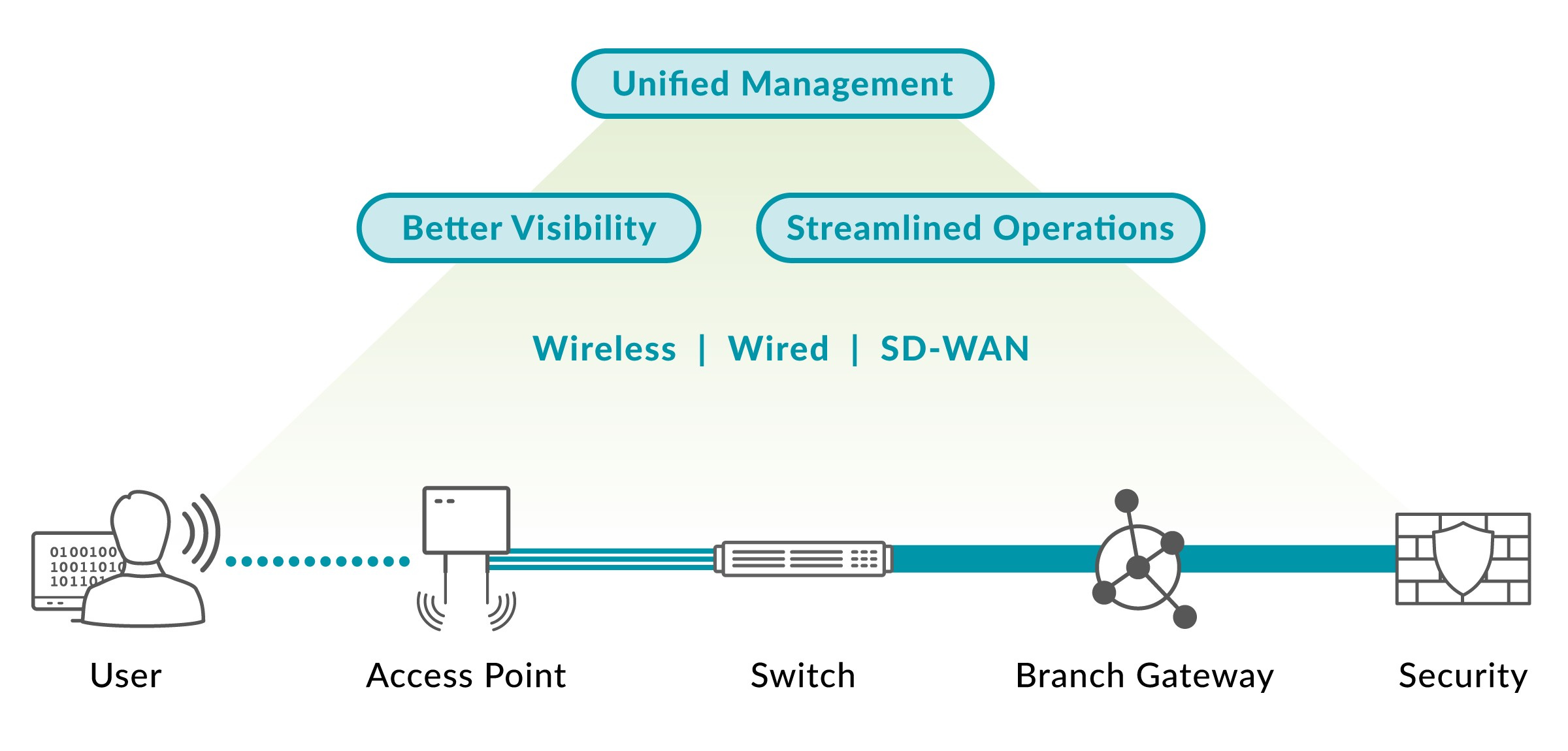What is SD-Branch?
SD-Branch is a branch network architecture designed to replace or supplement existing branch network systems. This solution enhances agility in remote and branch office environments through a centrally controlled platform. As the next step in branch technology evolution, SD-Branch supports SD-WAN, security, routing, and other operational functions that can be managed from a central location.

ad
How does SD-Branch work?
Think of SD-Branch as a combination of enterprise SD-WAN, SD-LAN (wired and wireless networking), and edge-to-cloud security, all within a software-defined framework. It is centrally managed from the cloud and designed for organizations with hundreds or thousands of branch locations.

This cloud-managed solution simplifies the management and operations of the complete networking stack within each branch location, as well as WAN connectivity. Networking components managed by SD-Branch include branch gateways, headend gateways, cloud virtual gateways, local wireless access points, and switches.
ad
Why is SD-Branch Important?
SD-Branch helps simplify IT operations at a branch, so organisations can operate more agilely while maintaining needed operational functionality. A single management system allows an organisation to manage and control all activities of its branch network and security operations. The SD-Branch architecture offers efficiencies with network operations through centralised management and reduced hardware footprint.
Network branch solution helps organizations startup a brand new site and centralised management provides the ability to fulfil the needs of fast-paced business expansion, minimising the time and amount of on-site information technology personnel. SD-Branch also provides the ability to quickly scale while ensuring higher security and reliability of the branch network. And SD-WAN helps reduce hardware costs through consolidated hardware versus the use of single all-in-one appliances.
Key capabilities of SD-Branch
SD-Branch includes the following critical capabilities:
- Centralized Management: A single pane-of-glass provides unified management, AIOps, and security for wired, wireless, and SD-WAN networks, including a centralized software licensing model.
- Simplified Deployment: Zero-touch provisioning with an installer app reduces the time, cost, and complexity of setting up branch office networks.
- Dynamic Segmentation: Enforces context-aware zero trust policies, eliminating the need for manual configuration of numerous VLANs with a single VLAN deployment.
- SD-WAN Orchestration: Automatically establishes IPsec tunnels between gateways, creating the SD-WAN overlay for large networks.
- End-to-End QoS: Provides application visibility and policy enforcement for over 3,200 applications, from Wi-Fi to WAN to the cloud.
- SaaS and IaaS Acceleration: Dynamically identifies optimal paths for high-priority SaaS applications and virtual gateways for AWS and Azure tunnels.
- Role-Based Policy: Enforces security and defines WAN policies.
- Unified Security: Adopts a scalable, flexible Zero Trust and SASE methodology from edge-to-cloud, LAN, and WAN, allowing organizations to implement SASE at their own pace.
What is the Difference Between SD-Branch and SD-WAN?
| Aspect | SD-WAN | SD-Branch |
|---|---|---|
| Origin | Software-Defined Networking (SDN) | Extends the value of SD-WAN |
| Function | Applies software-based network technologies to WAN connections | Addresses additional networking needs within the branch and LAN |
| Main Feature | Replaces traditional WAN routers, providing dynamic, policy-based traffic delivery | Automated management and troubleshooting of branch devices |
| Component Of | Secure Access Service Edge (SASE) | Extends orchestration and control beyond SD-WAN to branch infrastructure |
| Operations Supported | Optimizes traffic over multiple available connections | Supports SD-WAN, routing, security, WiFi, and LAN operations |
| Management | Centralized management of WAN connections | Centrally managed single hardware platform for comprehensive branch support |
FAQ’s
What is SD-Branch?
SD-Branch is a branch network architecture designed to replace or supplement existing branch network systems. It enhances agility in remote and branch office environments through a centrally controlled platform, supporting SD-WAN, security, routing, and other operational functions managed from a central location.
How does SD-Branch work?
Think of SD-Branch as a combination of enterprise SD-WAN, SD-LAN (wired and wireless networking), and edge-to-cloud security, all within a software-defined framework. Managed from the cloud, it simplifies the management and operations of the complete networking stack within each branch location, as well as WAN connectivity. It includes branch gateways, headend gateways, cloud virtual gateways, local wireless access points, and switches.
Can SD-Branch help reduce IT costs?
Yes, SD-Branch helps reduce IT costs by using consolidated hardware instead of multiple separate appliances, lowering hardware costs, and reducing the need for on-site IT personnel through centralized management. This allows for rapid scalability and operational efficiency.
How does SD-Branch support security?
SD-Branch adopts a scalable Zero Trust and SASE methodology, providing a unified security framework from edge-to-cloud, LAN, and WAN. It ensures secure connectivity for branch networks and allows organizations to implement SASE at their own pace.
What types of organizations can benefit from SD-Branch?
Organizations with hundreds or thousands of branch locations can benefit from SD-Branch. It simplifies the management and operations of branch network infrastructure, enhances agility, and supports a wide range of networking functions through a centrally managed platform.
Conclusion
SD-Branch streamlines branch network management by combining SD-WAN, SD-LAN, and edge-to-cloud security into a single, centrally managed platform. It simplifies deployment, cuts hardware costs, and boosts operational efficiency, making it ideal for organizations with extensive branch networks. SD-Branch enhances security and agility, offering a unified solution for optimizing branch IT environments.
ad


Comments are closed.